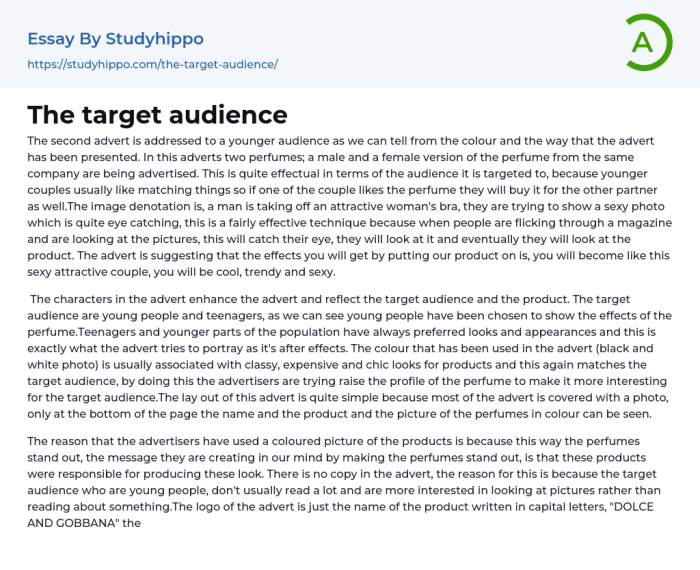Writing for a Target Audience sets the stage for creating content that resonates with specific readers, delving into strategies that captivate and connect on a deeper level.
As we explore the nuances of tailoring content to different audiences, we uncover the art of crafting compelling narratives that leave a lasting impact.
Understanding the Target Audience
Knowing your target audience is crucial when it comes to effective writing. By understanding who you are writing for, you can tailor your content to resonate with them, engage them, and ultimately achieve your writing goals.
Demographic information plays a significant role in shaping how you write for your target audience. Factors such as age, gender, location, education level, and income can all influence the language, tone, and style of your writing. For example, younger audiences may prefer more informal and conversational writing, while older audiences may appreciate a more formal and professional tone.
Different age groups often have distinct preferences when it comes to writing styles. Teenagers and young adults, for instance, may respond well to writing that is concise, visually appealing, and includes pop culture references. On the other hand, older adults may prefer more detailed explanations, traditional language, and a focus on practicality.
Understanding the interests of your target audience is key to shaping the content of your writing. Whether your audience is interested in technology, fashion, sports, or any other topic, incorporating relevant themes and references can make your writing more engaging and relatable. By aligning your content with the interests of your audience, you can establish a connection and build credibility as a writer.
Tailoring Content to the Audience
When it comes to writing for a specific audience, it’s crucial to tailor your content to resonate with them effectively. This involves adapting your tone, language, storytelling techniques, cultural references, and addressing their pain points and needs.
Adapting Tone and Language
- Understand the age group, interests, and preferences of your target audience to adjust your tone accordingly.
- Use language that is relatable and easy for your audience to understand, avoiding jargon or complex terminology.
- Consider the level of formality required based on the audience’s expectations and the context of your writing.
Using Storytelling Techniques
- Craft narratives that resonate with your specific audience, incorporating characters, settings, and plotlines that they can relate to.
- Create emotional connections through storytelling to engage and captivate your audience’s attention.
- Use anecdotes, personal experiences, or case studies to make your content more compelling and memorable.
Incorporating Cultural References, Writing for a Target Audience
- Research and incorporate cultural references that are familiar and relevant to your target audience, avoiding stereotypes or misconceptions.
- Use cultural symbols, events, or traditions to add depth and authenticity to your content, making it more relatable and engaging.
- Avoid cultural appropriation and ensure that your references are respectful and accurate.
Addressing Pain Points and Needs
- Identify the challenges, concerns, or desires of your audience and address them directly in your writing.
- Show empathy and understanding towards their struggles or aspirations, offering solutions or support where possible.
- Create content that provides value and meets the specific needs of your audience, positioning yourself as a trusted source of information or guidance.
Creating Personas for Audience Segmentation: Writing For A Target Audience

Creating audience personas is like crafting characters in a movie to represent different types of people who might be interested in your content. These personas help writers understand the needs, preferences, and behaviors of their target audience, allowing them to tailor their content to be more engaging and relevant.
Process of Creating Detailed Personas
To create detailed personas, writers need to conduct thorough audience research. This involves gathering data on demographics, psychographics, interests, and pain points of their target audience. By analyzing this information, writers can identify common traits and characteristics among different segments of their audience. These insights can then be used to create fictional personas that represent each segment in a detailed and nuanced manner.
- Collect demographic data such as age, gender, location, and income level.
- Gather psychographic information like interests, values, attitudes, and lifestyle choices.
- Identify pain points, challenges, and motivations that drive each segment of the audience.
- Create fictional personas with names, backgrounds, goals, and preferences based on the research findings.
Examples of Persona-guided Content Creation
Once personas are created, they serve as a compass for writers in crafting content that resonates with different audience segments. For example, if one persona represents a tech-savvy millennial interested in innovation, the content can focus on cutting-edge technology and trends. On the other hand, if another persona represents a middle-aged parent looking for practical solutions, the content can provide helpful tips and advice for everyday challenges. By aligning content with the needs and interests of each persona, writers can create more targeted and impactful messaging.
- Persona A: Tech Enthusiast – Content focuses on the latest tech gadgets and innovations.
- Persona B: Working Professional – Content provides career development tips and productivity hacks.
- Persona C: Fitness Fanatic – Content offers workout routines and healthy recipes.
Assistance of Personas in Tailoring Messaging
Personas play a crucial role in tailoring messaging to specific audience preferences. By understanding the unique characteristics and preferences of each persona, writers can create content that speaks directly to their needs and interests. Whether it’s adjusting the tone of voice, highlighting certain benefits, or addressing specific pain points, personas help writers deliver personalized and relevant messages that resonate with their target audience.
- Persona insights inform the language, style, and tone of the content to match the audience’s preferences.
- Personalized messaging based on persona traits enhances engagement and connection with the audience.
- Addressing specific pain points and offering tailored solutions demonstrates empathy and understanding towards the audience.
Utilizing Empathy in Writing for a Target Audience

Empathy plays a crucial role in understanding and connecting with the target audience. It involves putting yourself in the shoes of your readers, understanding their feelings, needs, and desires to create content that truly resonates with them.
Showing Empathy Through Writing
- Use inclusive language that makes your audience feel understood and valued.
- Address their pain points and offer solutions that cater to their specific needs.
- Share personal stories or anecdotes to build a connection and show that you understand what they are going through.
- Ask for feedback and actively listen to their responses to continuously improve your content.
Enhancing Communication with Empathy
Empathy enhances the effectiveness of communication with the target audience by creating a sense of trust and understanding. When your audience feels like you truly understand them, they are more likely to engage with your content, share it with others, and take the desired action.
Examples of Empathy-Driven Content
For example, a skincare brand that acknowledges the struggles of acne-prone skin and offers gentle, effective solutions can resonate with teenagers facing similar issues.
Similarly, a parenting blog that shares honest stories about the challenges of raising children can connect with tired and overwhelmed parents, creating a supportive community.
